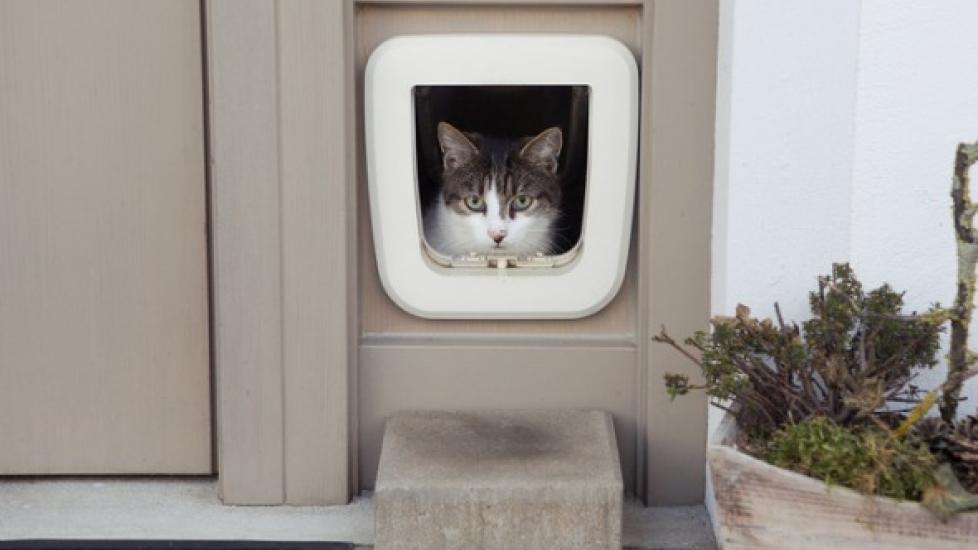How to Train Your Cat to Use the Cat Door
By Carol McCarthy
Even if you provide your indoor cat with plenty of stimulating cat toys and climbing surfaces, most will crave a walk on the wild side. And if you allow your cat to go outdoors sometimes, constantly playing doorman to a feline who likes to come and go quickly becomes tiresome.
To allow your cat to venture outside—and easily get back indoors—consider installing a cat door. These doors, also known as cat flaps, can give your pet the freedom she craves without disturbing the household. Not all cats are naturally comfortable with using a cat door, but by following these tips, you can train her to use a cat door without hesitation.
Getting Your Cat Used to a Cat Door
Be sure to choose a cat door that is large enough for your pet to comfortably pass through, and double-check before installing.
To start the training, if possible, tape or prop the door open or remove the flap entirely, advises Dr. Brian Glenn Collins, DVM, section chief of Community Practice Service at Cornell University’s College of Veterinary Medicine. “Some cats will just jump right through, especially if they are young and playful. Don't push the cat through the door, which may just scare them or make them leery of the door, and don't expect the cat to use the door right away,” he says.
Give your cat a chance to experiment with the opening and get used to slipping through. Be certain they are comfortable going in and out before you introduce the flap, he suggests.
“Another trick is to replace the door (again temporarily) with something that blocks half of the entrance, like a cloth that hangs down part way. This will show your cat that it is OK to push through and nothing scary will happen,” suggests Dr. Cathy Lund, veterinarian and owner of the feline-only veterinary practice City Kitty in Rhode Island. “For nervous cats, increase the size of the cloth until it hangs down and covers the entire door. Then give it some time to make sure that your cat is comfortable with the setup. The next step is using the actual door.”
Enticing Your Cat to Go Through the Cat Door
“It’s most important that your cat not be surprised or startled by the door mechanism and that it is easy and rewarding to go through,” Dr. Lund says.
Pet parents can use high-value cat treats, such as Greenies® Feline SmartBites or Life Essentials® freeze-dried chicken dog and cat treats, to make using the door rewarding. But don't overdo it with the treats, and be careful if your cat has dietary restrictions, Dr. Collins advises.
“Treats can seal the deal,” Dr. Lund agrees. Some cats value cuddling or high-value cat toys more than treats, so reward your pet with something she values, Dr. Lund notes. “Anything your cat loves and thinks is special can be used to help him feel secure about going through the door. Positive reinforcement is all about rewards.”
Recommended Products
Why Won’t My Cat Use the Cat Door?
Some very nervous and skittish cats might feel anxious about going through a covered doorway, but most cats can be trained to use cat doors, Dr. Lund says. When training your cat, be sure not to lock the cat door, because that will make her less likely to want to go through it when it is unlocked.
“After she understands that the door is a reliable and predictable opening, it will be possible to lock it during times that you don’t want your cat to be able to go outside,” says Dr. Lund.
Dr. Collins agrees that most cats will learn to adapt if given enough time and assuming the cat is physically able to hop through the cat flap. Some older cats may have difficulty using a cat door due to mobility issues.
Safety Factors to Consider When Installing a Cat Door
Ideally, your cat door will allow your pet to access a safe and escape-proof enclosure.
If you use it to give your cat access to the outdoors in general, be sure the door opens to a relatively safe area and not out to a driveway or adjacent to a busy street, Dr. Lund advises. “… Be certain that there are no dangers on the other side of the door, such as another cat that might be waiting to ambush, predators, or falling ice or snow,” Dr. Collins says.
You will want to install a cat door that locks, such as Cat Mate® lockable cat flap or PetSafe® 4-way locking cat door, so that the cat cannot go outside when you don't want her to, and so that other animals (raccoons or your neighbor’s cat, for example) can't come in when you are not home to supervise, Dr. Collins says.
Recommended Products
For ultimate peace of mind, Dr. Lund prefers electronic cat doors that open only for special keys worn on the collar such as PetSafe® Electronic SmartDoor. There are also cat doors that can read your pet’s microchip and only allow access for specific pets, like the Cat Mate® Elite Microchip Cat Flap.
Both of these options are helpful in making sure that unwanted pets or wildlife do not gain access to a house, she notes.
Featured Image: iStock.com/w-ings





